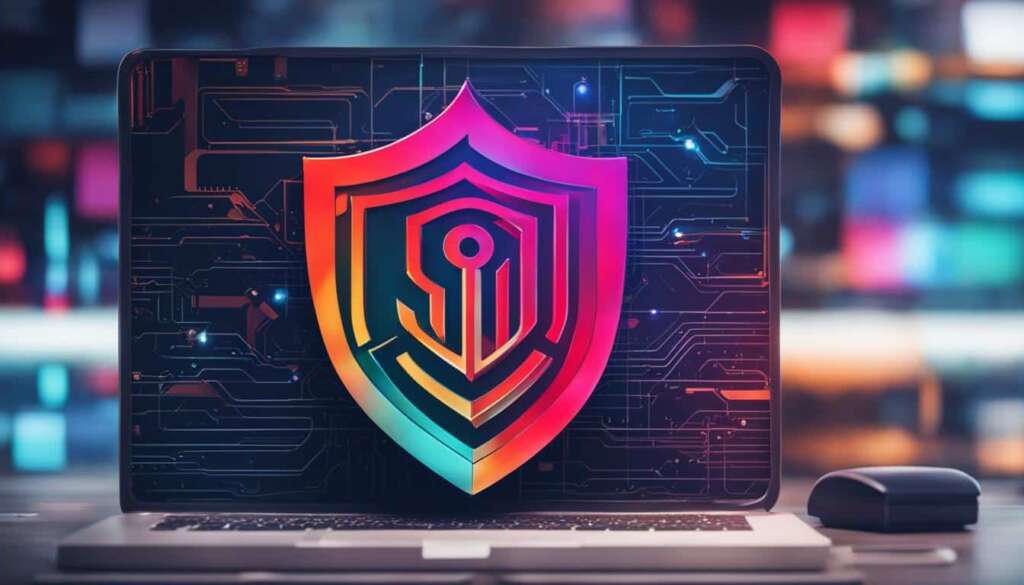Table of Contents
Protecting online assets and ensuring network security have become paramount in today’s digital economy. With the increasing reliance on technology, the risk of cyber threats has also escalated. In this article, we will delve into the importance of cybersecurity and how it safeguards against online security breaches, data protection, and information security in the digital realm.
Cybersecurity acts as a shield, defending against IT security vulnerabilities, internet security risks, and cyber threats. As our lives and businesses become more interconnected, so does the need for robust cyber defense measures. By implementing cybersecurity protocols, we can safeguard data privacy and protect against cyber attacks that pose a significant risk to individuals and organizations in the digital economy.
The Importance of Data Privacy and Protection
Safeguarding data privacy and protecting sensitive information have become fundamental concerns in the digital economy. With the increasing amount of personal and financial data being stored and transmitted online, individuals and organizations must implement robust cybersecurity measures to ensure the security of their data.
Data privacy refers to the protection of personal information and the control individuals have over how their data is collected, used, and shared. It encompasses the right to be informed about data processing activities, the right to access and correct personal data, and the right to be forgotten or have data erased. Data protection, on the other hand, involves safeguarding data from unauthorized access, disclosure, alteration, or destruction.
Implementing cybersecurity measures such as encryption, secure authentication, and access controls is crucial in protecting data from potential breaches. Encryption converts data into an unreadable format, making it inaccessible to unauthorized individuals. Secure authentication methods, like two-factor authentication, provide an additional layer of security by requiring users to verify their identity through multiple means. Access controls ensure that only authorized individuals have access to specific data or systems, minimizing the risk of data breaches.
The Consequences of Neglecting Data Privacy and Protection
“Data breaches can have severe consequences, both for individuals and organizations. In addition to financial losses, data breaches can result in reputational damage, loss of customer trust, and legal consequences.”
Neglecting data privacy and protection can have severe consequences, both for individuals and organizations. In addition to financial losses, data breaches can result in reputational damage, loss of customer trust, and legal consequences. Furthermore, the General Data Protection Regulation (GDPR) in the European Union and other data protection regulations globally impose significant fines for non-compliance, making data privacy and protection a legal obligation.
By prioritizing data privacy and protection, individuals and organizations can establish trust with their customers, protect their reputation, and comply with legal requirements. Safeguarding data is an ongoing process that requires continuous monitoring, updating security measures, and educating individuals about cybersecurity best practices.
| Data Privacy Measures | Data Protection Measures |
|---|---|
| Inform individuals about data processing activities | Implement encryption to protect data |
| Obtain informed consent for data collection | Implement secure authentication methods |
| Provide individuals with access to their data | Establish access controls to prevent unauthorized access |
| Enable individuals to correct or erase their data | Regularly update security measures |
| Ensure compliance with data protection regulations | Educate individuals about cybersecurity best practices |
Understanding Cyber Threats and Risks
Cyber threats pose significant risks to individuals and organizations operating in the digital economy. As technology advances, so do the tactics employed by cybercriminals to exploit network vulnerabilities and compromise data security. It is crucial to understand the various cyber threats and risks to effectively implement cybersecurity strategies and protect against potential breaches.
One of the most common cyber threats is phishing attacks, where cybercriminals use deceptive techniques to trick unsuspecting individuals into revealing sensitive information or clicking on malicious links. These attacks can lead to data breaches and compromise the integrity of personal or organizational systems. Therefore, it is essential to educate individuals about the potential dangers of phishing and how to identify and avoid such attacks.
Another significant cybersecurity risk is network vulnerabilities. As technology advances, so do the complexity and sophistication of the networks we rely on. Unfortunately, with increased complexity comes increased vulnerability. Cybercriminals can exploit these vulnerabilities to gain unauthorized access to sensitive data, disrupt operations, or launch malware attacks. Regular security audits and vulnerability scans are crucial in identifying and remedying network vulnerabilities before they can be exploited by malicious actors.
In today’s interconnected world, data breaches are a significant concern for individuals and organizations. Data breaches occur when unauthorized individuals gain access to sensitive information, such as personal records or financial data. The consequences of a data breach can be severe, leading to financial loss, reputational damage, and legal repercussions. Implementing robust security measures, such as encryption, access controls, and intrusion detection systems, can help mitigate the risk of data breaches and protect valuable information.
| Cyber Threat | Risk Level | Impact |
|---|---|---|
| Phishing attacks | High | Potential data breaches, financial loss, reputation damage |
| Network vulnerabilities | Medium | Unauthorized access, disruption of operations, malware attacks |
| Data breaches | High | Financial loss, reputational damage, legal repercussions |
Understanding cyber threats and risks is crucial in developing effective cybersecurity strategies. By staying informed about the latest threats, implementing robust security measures, and conducting regular audits, individuals and organizations can mitigate the risk of cyber attacks and protect their valuable data.
Best Practices for Cybersecurity
Network Security
Ensuring robust network security is one of the fundamental best practices for cybersecurity. It involves implementing measures to protect the organization’s network infrastructure from unauthorized access and potential breaches. Some key network security practices include:
- Using firewalls and intrusion detection systems to monitor network traffic and detect any suspicious activities.
- Implementing secure Wi-Fi protocols, such as WPA2, to prevent unauthorized access to wireless networks.
- Segmenting the network to isolate critical systems and reduce the impact of a potential breach.
- Regularly updating network equipment and applying security patches to address any vulnerabilities.
By prioritizing network security, organizations can create a strong foundation for protecting their data and systems.
Data Protection
Data protection is another crucial component of cybersecurity best practices. It involves implementing measures to safeguard sensitive information from unauthorized access, loss, or corruption. Some key data protection practices include:
- Encrypting sensitive data to ensure that it remains secure, both during transit and storage.
- Implementing access controls and user permissions to limit access to sensitive data to authorized individuals only.
- Regularly backing up data to prevent permanent loss in the event of a cyber attack or system failure.
- Implementing data loss prevention (DLP) solutions to monitor and prevent the unauthorized transmission of sensitive data.
By implementing strong data protection measures, organizations can minimize the risk of data breaches and ensure the privacy and integrity of their data.
Employee Training
Human error is one of the leading causes of security breaches, making employee training a critical component of cybersecurity best practices. By educating employees about cybersecurity threats and providing them with the knowledge and skills to identify and respond to potential risks, organizations can significantly enhance their overall security posture. Some key elements of effective employee training include:
- Providing regular training sessions on cybersecurity best practices, including password management, phishing awareness, and social engineering tactics.
- Conducting simulated phishing exercises to test employees’ ability to identify and report suspicious emails.
- Encouraging a culture of cybersecurity awareness and accountability throughout the organization.
- Establishing clear policies and procedures regarding the handling of sensitive data and the use of company technology.
By investing in employee training, organizations can empower their workforce to become the first line of defense against cyber threats.
Security Audits
Regular security audits are essential in identifying vulnerabilities, assessing the effectiveness of existing security controls, and ensuring compliance with industry regulations and standards. These audits involve a comprehensive review of an organization’s cybersecurity practices, infrastructure, and processes. Some key elements of effective security audits include:
- Conducting regular vulnerability assessments and penetration testing to identify and address potential weaknesses in the network and systems.
- Reviewing access controls and user permissions to ensure that they are aligned with the principle of least privilege.
- Assessing the effectiveness of security controls, such as firewalls, antivirus software, and intrusion detection systems.
- Ensuring compliance with industry-specific regulations and standards, such as the General Data Protection Regulation (GDPR) or the Payment Card Industry Data Security Standard (PCI DSS).
By regularly conducting security audits, organizations can proactively identify and address potential security risks before they can be exploited by malicious actors.
| Network Security Best Practices | Data Protection Best Practices | Employee Training Best Practices | Security Audit Best Practices |
|---|---|---|---|
| Use firewalls and intrusion detection systems | Encrypt sensitive data | Provide regular training sessions | Conduct vulnerability assessments |
| Implement secure Wi-Fi protocols | Implement access controls and user permissions | Conduct simulated phishing exercises | Review access controls and user permissions |
| Segment the network | Regularly back up data | Encourage a culture of cybersecurity awareness | Assess the effectiveness of security controls |
| Regularly update network equipment | Implement data loss prevention solutions | Establish clear policies and procedures | Ensure compliance with industry regulations |
The Role of Artificial Intelligence in Cyber Defense
Artificial intelligence (AI) is revolutionizing the field of cybersecurity, offering advanced capabilities for threat detection and mitigation. With the ever-increasing complexity and volume of cyber attacks, AI-powered systems play a critical role in enhancing cyber defense strategies. By harnessing the power of machine learning algorithms, AI can analyze massive amounts of data and identify patterns, anomalies, and potential threats that may go unnoticed by traditional security measures.
AI in cybersecurity enables real-time monitoring and proactive response to emerging threats. With its ability to continuously learn and adapt, AI can detect and respond to cyber attacks with greater speed and precision. Whether it’s identifying suspicious network activity, detecting malware, or predicting future attack trends, AI algorithms provide valuable insights that help organizations stay one step ahead of cybercriminals.
One of the key applications of AI in cybersecurity is anomaly detection. By establishing a baseline of normal behavior, AI systems can identify deviations that indicate a potential threat. This helps in early detection and response, minimizing the damage caused by cyber attacks. AI can also automate routine security tasks, such as system patching and vulnerability assessments, freeing up cybersecurity professionals to focus on more critical tasks.
The Benefits of AI in Cyber Defense
AI-powered cyber defense offers several benefits that contribute to a more robust and proactive security posture:
- Improved threat detection: AI algorithms can analyze vast amounts of data in real-time, enabling the identification of even the most advanced and sophisticated cyber threats.
- Reduced response time: AI systems can quickly analyze and prioritize threats, enabling rapid incident response and minimizing the impact of cyber attacks.
- Enhanced accuracy: AI algorithms are capable of detecting subtle patterns and anomalies that may indicate a cyber attack, reducing false positives and improving overall accuracy.
- Continuous learning: AI systems can continuously learn and adapt to evolving threats, ensuring that cybersecurity defenses remain up to date in the face of rapidly changing attack methods.
- Human-machine collaboration: AI augments the capabilities of cybersecurity professionals, providing them with valuable insights and automating routine tasks, allowing them to focus on more complex and strategic activities.
In conclusion, the integration of artificial intelligence into cybersecurity practices has transformed the way organizations defend against cyber threats. Leveraging AI’s capabilities in threat detection, anomaly detection, and real-time response empowers organizations to stay ahead of cybercriminals and protect their digital assets. As the cybersecurity landscape continues to evolve, AI will undoubtedly play an increasingly vital role in ensuring a secure and resilient digital future.
| AI in Cyber Defense | Benefits |
|---|---|
| Advanced threat detection | Improved accuracy |
| Anomaly detection | Reduced response time |
| Real-time monitoring | Enhanced accuracy |
| Automated security tasks | Continuous learning |
| Human-machine collaboration |
Collaborating with Third-Party Vendors for Cybersecurity
Effective cybersecurity in the digital economy often requires collaboration with third-party vendors. Many organizations rely on these vendors for various services, such as cloud storage and software development. However, it is essential to establish robust cybersecurity partnerships and implement vendor risk management practices to ensure the security of shared networks and data.
When collaborating with third-party vendors, conducting regular security audits is crucial. These audits help identify any vulnerabilities or weaknesses in the vendor’s systems and ensure that adequate security measures are in place. By assessing the vendor’s cybersecurity practices, organizations can mitigate the risk of potential breaches and address any security gaps.
“The security of our shared networks and data is a top priority, and we have established strong cybersecurity partnerships with our third-party vendors. Regular security audits and assessments are conducted to ensure that all parties are taking necessary precautions to protect against cyber threats.”
– Chief Information Security Officer, XYZ Corporation
In addition to security audits, organizations should also implement contractual agreements that outline the specific cybersecurity requirements for the vendor. These agreements should address data protection, incident response protocols, and the vendor’s responsibility in case of a security breach. By clearly defining expectations and responsibilities, organizations can hold vendors accountable for maintaining a high level of security.
Supply chain security is another critical aspect of collaborating with third-party vendors. Organizations need to ensure that their vendors have secure supply chains to prevent any compromise in the integrity or confidentiality of the products or services provided. This can include verifying the security measures implemented during the development, distribution, and maintenance of the products or services.
By establishing strong cybersecurity partnerships, implementing vendor risk management practices, conducting security audits, and ensuring supply chain security, organizations can enhance their overall cybersecurity posture. Collaboration with third-party vendors can be a valuable asset in strengthening defenses and protecting against cyber threats in the digital economy.
Table: Key Elements of Vendor Risk Management
| Element | Description |
|---|---|
| Vendor Evaluation | Assessing the vendor’s cybersecurity practices, experience, and reputation before entering into a partnership. |
| Security Audits | Conducting regular audits to identify vulnerabilities and weaknesses in the vendor’s systems. |
| Contractual Agreements | Including specific cybersecurity requirements in the contractual agreements, including data protection and incident response protocols. |
| Supply Chain Security | Verifying the security measures implemented in the development, distribution, and maintenance of the vendor’s products or services. |
| Ongoing Monitoring | Continuously monitoring the vendor’s cybersecurity practices and promptly addressing any security issues that arise. |
Healthcare Cybersecurity: Protecting Medical Data and Safeguarding Patient Privacy
In the healthcare industry, cybersecurity is of utmost importance to protect sensitive medical data and ensure the privacy of patients. With the increasing digitization of healthcare records and the adoption of Internet of Things (IoT) devices, healthcare organizations face unique cybersecurity risks. It is crucial for healthcare providers to implement robust cybersecurity measures to mitigate these risks and safeguard the industry from potential cyber threats.

The Challenges of Medical Data Protection
Medical data contains highly personal and sensitive information, making it a prime target for hackers and cybercriminals. From patient records to test results and prescriptions, healthcare organizations store a vast amount of data that must be protected from unauthorized access. Implementing strong encryption, access controls, and secure storage solutions is essential to maintain the confidentiality and integrity of medical data.
Securing IoT Devices in Healthcare
The increasing use of IoT devices in healthcare, such as wearable health trackers and remote monitoring systems, brings additional cybersecurity challenges. These devices often collect and transmit sensitive patient data, making them potential entry points for cyber attacks. Healthcare organizations must ensure the security of IoT devices by implementing strict access controls, regular software updates, and monitoring for any potential vulnerabilities.
Furthermore, healthcare providers should prioritize the education and awareness of both staff and patients regarding cybersecurity best practices. Training programs can help personnel identify and respond to potential threats, while patients can be educated about the importance of protecting their personal health information and the potential risks associated with IoT devices. By fostering a culture of cybersecurity awareness, the healthcare industry can stay one step ahead of cyber threats and ensure the privacy and safety of patients.
| Healthcare Industry Risks | Cybersecurity Measures |
|---|---|
| Unauthorized access to patient records | Implement strict access controls and strong authentication methods |
| Ransomware attacks targeting healthcare organizations | Regularly backup data and implement robust malware detection systems |
| Insider threats and employee negligence | Provide comprehensive cybersecurity training for staff members |
| IoT vulnerabilities and potential data breaches | Implement security protocols for IoT devices and monitor for any vulnerabilities |
The Role of Cybersecurity in the Financial Services Industry
In today’s digital landscape, the financial services industry faces numerous cybersecurity risks and challenges. As financial institutions handle sensitive customer data, conduct online transactions, and store valuable financial information, it has become imperative to prioritize cybersecurity measures to protect against threats. This section will explore the crucial role of cybersecurity in the financial services sector, focusing on key areas such as financial data protection, payment security, fraud prevention, and banking industry risks.
Financial Data Protection
Financial institutions deal with vast amounts of sensitive data, including personal and financial information. It is essential for these organizations to implement robust cybersecurity measures to safeguard this data from unauthorized access or breaches. Encryption techniques, secure data storage practices, and access controls are used to protect financial data from cybercriminals. By deploying these measures, financial institutions can mitigate the risk of data breaches, ensuring the security and trust of their customers.
Payment Security
In an era where digital payments are becoming increasingly popular, ensuring payment security is of utmost importance in the financial services industry. Cybercriminals often target payment systems to steal valuable financial information or conduct fraudulent transactions. To combat these risks, financial institutions employ advanced security protocols, including secure payment gateways, tokenization, and two-factor authentication. By fortifying payment security, financial institutions not only protect their customers but also maintain the integrity of the financial system as a whole.
Fraud Prevention
Financial fraud continues to pose a significant threat to the industry, and detecting and preventing fraudulent activities is an ongoing challenge. Cybersecurity plays a critical role in fraud prevention by employing advanced algorithms, machine learning techniques, and behavioral analysis to identify suspicious patterns or activities. By leveraging these technologies, financial institutions can detect and prevent fraud in real-time, safeguarding their customers’ assets and maintaining the overall trustworthiness of the financial system.
Cybersecurity Training and Skill Development
As the digital landscape continues to evolve, the demand for skilled cybersecurity professionals is on the rise. Organizations need competent IT professionals who can effectively protect their networks, systems, and data from cyber threats. Cybersecurity training and skill development play a crucial role in equipping individuals with the knowledge and expertise required to tackle these challenges head-on.
One of the key aspects of cybersecurity education is staying updated with the latest industry trends and technologies. Training programs and courses provide IT professionals with insights into emerging threats and best practices for mitigating them. By continually enhancing their skills and knowledge, cybersecurity professionals can stay one step ahead of cybercriminals.
Furthermore, cybersecurity training goes beyond technical skills. It also focuses on developing critical thinking and problem-solving abilities. These skills enable professionals to analyze complex cybersecurity situations, identify vulnerabilities, and devise effective strategies to protect against cyber attacks. This holistic approach to skill development empowers IT professionals to make informed decisions and take proactive measures to safeguard digital assets.
Benefits of Cybersecurity Training and Skill Development:
- Enhanced understanding of cybersecurity concepts and methodologies
- Ability to identify and address security vulnerabilities
- Proficiency in implementing cybersecurity best practices
- Effective incident response and threat mitigation
- Improved collaboration and communication within the cybersecurity workforce
Cybersecurity training also plays a vital role in bridging the cybersecurity skills gap. As the number of cyber threats increases, there is a growing need for a skilled workforce to combat them. Training programs not only help individuals acquire the necessary skills but also contribute to expanding the pool of cybersecurity professionals.

| Training Program | Description |
|---|---|
| Certified Ethical Hacker (CEH) | A comprehensive program that equips professionals with the skills to think like malicious hackers and identify vulnerabilities to strengthen organizational security. |
| CompTIA Security+ | A vendor-neutral certification that validates foundational cybersecurity skills and knowledge, covering essential topics such as network security and incident response. |
| GIAC Security Essentials (GSEC) | A certification focusing on the knowledge and skills required to secure an organization’s information assets by implementing and managing appropriate security policies. |
Investing in cybersecurity training and skill development is not only crucial for organizations but also for individuals seeking to build a successful career in the field. By staying updated, developing critical skills, and acquiring recognized certifications, cybersecurity professionals can contribute to a safer digital future.
Conclusion
In conclusion, cybersecurity plays a crucial role in safeguarding the digital economy and protecting against cyber threats. With the increasing reliance on technology, it is imperative for individuals and organisations to prioritise cybersecurity measures and stay updated on emerging threats. By implementing best practices, leveraging artificial intelligence, and fostering collaboration, we can navigate the evolving landscape of cyber threats and ensure a secure digital future.
Cybersecurity is of utmost importance in today’s digital landscape. It is vital for individuals and organisations to recognise the significance of protecting online assets and mitigating online threats. As our reliance on technology grows, so does the risk of cyber attacks. Implementing strong cybersecurity measures is essential to safeguard data, ensure network security, and protect against cyber threats.
With the ever-evolving nature of cyber threats, it is imperative to understand the importance of data privacy and protection. Safeguarding sensitive information through encryption, secure authentication, and access controls is crucial in mitigating risks and preventing unauthorized access or breaches. Implementing robust cybersecurity measures is not only a necessity but a responsibility that individuals and organisations must uphold to protect their digital assets.
Ensuring cybersecurity in the digital economy requires a multi-faceted approach that involves continuous education, collaboration, and the integration of artificial intelligence. By investing in cybersecurity training and skill development, we can cultivate a skilled workforce that is equipped to combat evolving cyber threats. Additionally, fostering collaboration with third-party vendors and leveraging AI technology can enhance threat detection, strengthen defenses, and promote a secure online environment for all.
FAQ
What is cybersecurity and why is it important in the digital economy?
Cybersecurity refers to the practice of protecting online assets and data from unauthorized access or breaches. It is essential in the digital economy to safeguard sensitive information and ensure network security to mitigate the risk of cyber attacks.
What measures can be taken to protect data privacy and sensitive information online?
To protect data privacy and sensitive information online, individuals and organizations can implement robust cybersecurity measures such as encryption, secure authentication, and access controls to prevent unauthorized access.
What are the common cyber threats and risks that individuals and businesses face?
Common cyber threats include phishing attacks, malware, and ransomware, which exploit vulnerabilities in networks and systems. Understanding these threats and the potential risks they pose is crucial in implementing effective cybersecurity strategies.
What are some best practices for cybersecurity?
Best practices for cybersecurity include conducting regular security audits, implementing strong passwords and multi-factor authentication, keeping software up to date, and educating employees about cybersecurity threats and best practices.
How does artificial intelligence enhance cybersecurity?
Artificial intelligence algorithms can analyze vast amounts of data to identify anomalies and potential threats, enabling rapid response and mitigation measures. Incorporating AI into cybersecurity strategies can significantly strengthen defenses against cyber attacks.
How should organizations collaborate with third-party vendors to ensure cybersecurity?
Organizations should establish robust cybersecurity partnerships with third-party vendors and implement vendor risk management practices. Regular security audits and assessments should be conducted to ensure the security of shared networks and data.
What are the cybersecurity challenges in the healthcare industry?
The healthcare industry faces unique cybersecurity challenges due to the sensitive nature of medical data and the increasing adoption of Internet of Things (IoT) devices. Ensuring the security of medical records, protecting patient privacy, and addressing IoT vulnerabilities are critical in safeguarding the healthcare industry from cyber threats.
How can cybersecurity protect the financial services sector?
Implementing robust cybersecurity measures such as encryption, secure payment gateways, and fraud detection systems is crucial in protecting against financial fraud and ensuring the security of customers’ financial information in the financial services sector.
How can individuals and organizations develop cybersecurity skills?
Investing in cybersecurity training and skill development through training programs and educational courses can equip individuals with the knowledge and skills needed to effectively protect networks, systems, and data. Developing a skilled cybersecurity workforce is vital in combating evolving cyber threats.
Source Links
- https://www.ncbi.nlm.nih.gov/pmc/articles/PMC10422504/
- https://www.linkedin.com/pulse/7-ways-navigate-cyber-threats-cybersecurity-best-practices
- https://thehague.com/businessagency/navigating-around-the-cyberthreats-the-digital-economy













